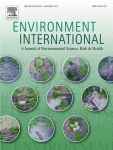Environment International 44
Overview of new articles on POPs in a new issue of the Environment International journal.

Pages 1-6
Susan D. Shaw, Michelle L. Berger, Liesbeth Weijs, Adrian Covaci
- First study on tissue-specific biomagnification of BFRs in the northwest Atlantic.
- Tri- to hexa-BDEs in seal liver and blubber highly biomagnified from fish to seals.
- Levels of α-HBCD were higher in seal liver than in blubber and did not biomagnify.
- Differences in the retention of BFRs were observed in male and female pups.
- BDE-209 was higher in liver than in blubber, suggesting selective hepatic retention
Pages 53-58
Ingela Helmfrid, Marika Berglund, Owe Löfman, Gun Wingren
- High environmental levels of PCB and metals were identified in the study area.
- Increased risks for lymphoma and testicular cancer were found among men.
- Consumption of local fish is related to increased cancer risk among inhabitants.
- Early life exposure in the study area was related to preterm delivery among mothers.
Pages 59-67
Samira Salihovic, Erik Lampa, Gunilla Lindström, Lars Lind, P. Monica Lind, Bert van Bavel
- We determined levels of 23 POPs in 1016 elderly men and women from Sweden.
- We used a method based on SPE and HRGC-HRMS to assess exposure to 16 PCBs, 5 OC pesticides, one PBDE, and one dioxin.
- The levels of the majority of POPs were comparable or similar to other studies from Sweden and Europe.
- We found significant gender differences in levels of specific POPs.
- Levels of HCB, OCDD, and PCB congeners #74, #105, and #118 were found to be higher in women.
Pages 92-99
Anne L. Myers, Patrick W. Crozier, Paul A. Helm, Corina Brimacombe, Vasile I. Furdui, Eric J. Reiner, Debbie Burniston, Chris H. Marvin
- Lake Ontario water and sediment were analyzed for perfluoroalkyl substances (PFASs).
- Shorter chain PFASs were predominant in sediment and water from urban watersheds.
- Longer chain PFASs were predominant in sediment from major depositional basins.
- Sediment core temporal trends contrasted those in Niagara River suspended solids.
- Temporal trends from a range of matrices should be considered in monitoring studies.
Number of persistent organic pollutants detected at high concentrations in a general population
Pages 106-111
Miquel Porta, José Pumarega, Magda Gasull
- 34% of participants had concentrations in the top quartile of ≥3 of 8 POPs.
- 48% of women 60–74years old had concentrations of ≥6 POPs in the top quartile.
- It is not accurate to state that most of the population has low concentrations of POPs.
- We integrate the number of compounds detected per person and the dose of each compound.
- The indicators complement other measures of POP body burden in biomonitoring surveys.
7.5.2012




